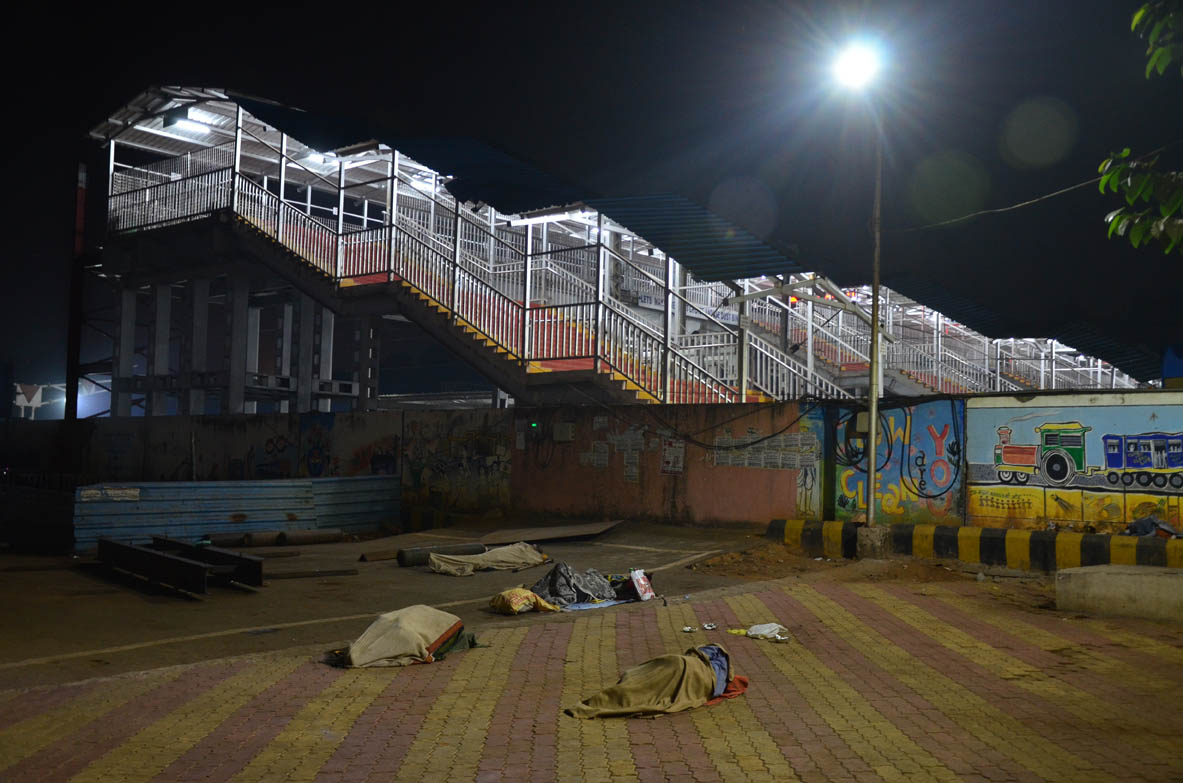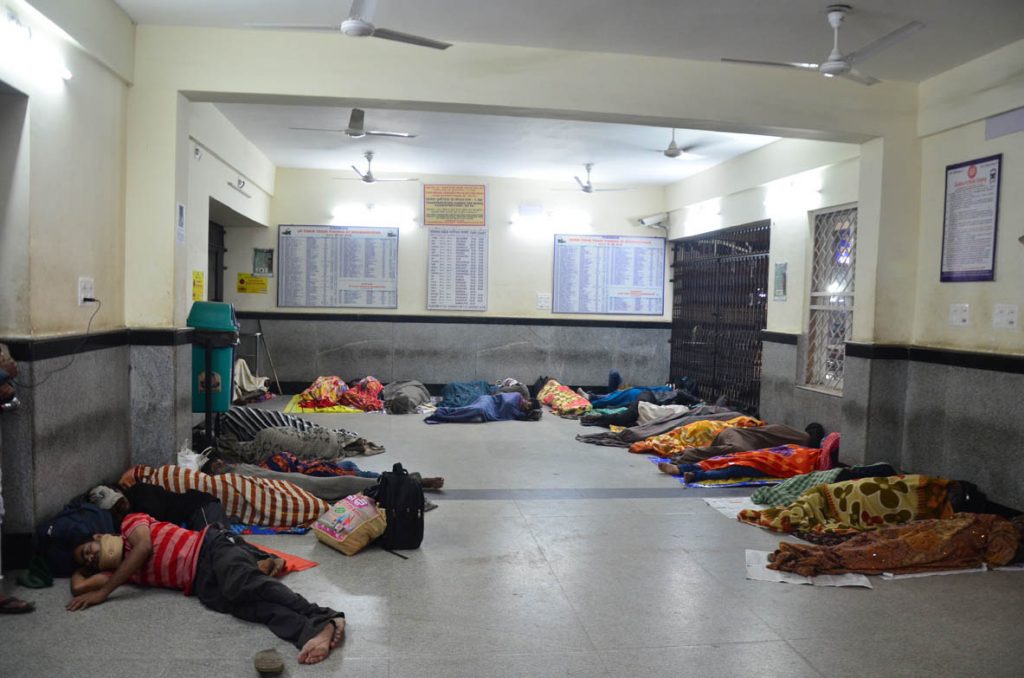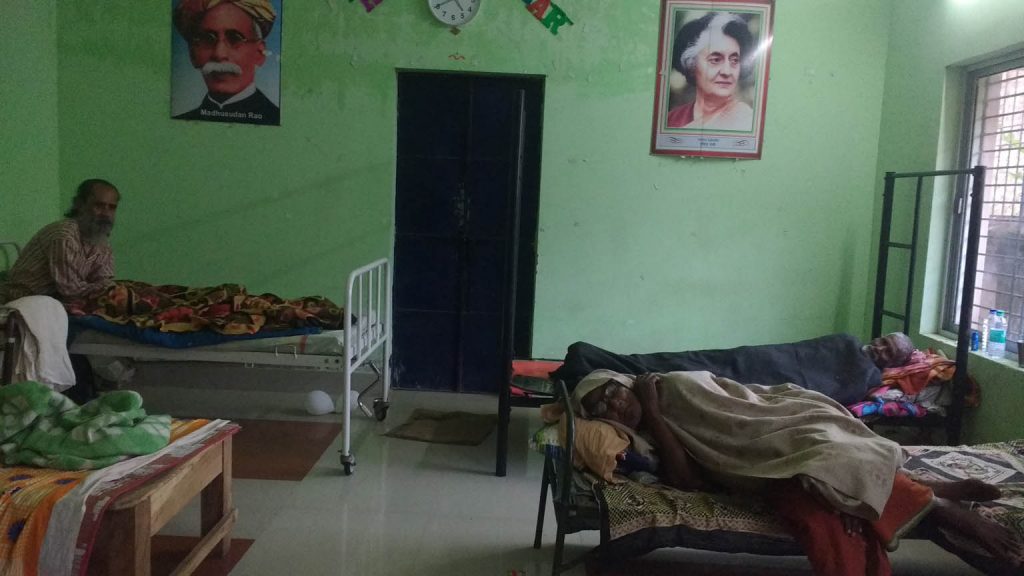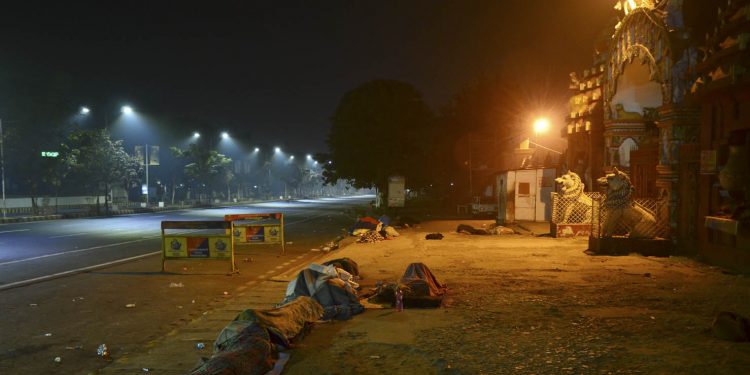With temperatures dipping to single digits in Bhubaneswar, the homeless are facing a nightmare. Many elderly people, physically challenged and unemployed youth can be seen on the pavements and under the flyovers trying desperately to get respite from the bone-chilling cold. The government as well as some private organisations have set up shelter homes. Yet, surprisingly, most of these homeless people are reluctant to move to the homes.
Sunday POST tried to ascertain the reasons behind the unwillingness of these people to stay in shelter homes.
Suriya Reddy, 80, once earned his livelihood by pulling a rickshaw. A resident of Ganjam, he moved to Cuttack in search of a job and settled down in the city. His life took a U-turn following the death of his wife who suffered from an unknown disease. His children also died of the same disease. Shattered by their deaths, Suriya took to alcohol to get rid of his anxieties. In the meantime, he was diagnosed with leprosy. He gave up work and started begging at Ram Mandir Square for sustenance. Asked about shelter homes, he says, “I do not know if there is such a provision for homeless people. I usually sit near the Ram Mandir and sleep on the railway platform.”
Devendra Mishra from Nayagarh says, “I worked as a peon in Reserve Bank of India, Bhubaneswar for 12 years. But my job was not regularised, so I quit and started working in a catering unit. I met with a road mishap following which I started begging on the streets. I am unmarried and I don’t have anyone to look after me, so I did not know what else to do.”
Devendra lived for a few months in a shelter home. He says, “I spent nine months at Unit VI shelter home when it was launched. Though all the inmates were provided meals apart from tea, snacks and other essential commodities, we were not allowed to take things like bidi, gutkha and ganja. Frankly speaking, I cannot live without consuming hemp. I was asked to leave when I sought permission from the authorities to take these intoxicants. Now I eat, drink and sleep at Ram Mandir Square.”

Many people are averse to maintaining discipline and Rabi Pradhan, who used to work as a daily wager, is one of them. He says, “I am from Ganjam. However, I can no longer work due to old age ailments. I did not want to be a burden on my children, so I left my family. I did not go to any shelter home because I am a free bird. I am not used to following anyone’s orders. For some time, I stayed in an ashram. These people behave with us very cruelly just because we are homeless. Though, there are several organisations providing free shelter to homeless, I don’t feel like going there to lead the life of a caged bird.”
There are others who are not comfortable at the shelter homes as they find the life there is full of boredom. Swami, who is from AP, has been in Bhubaneswar since 1988. He says, “I started begging after one of my legs became infected. I was taken to a shelter home near Ashok Nagar where I felt lonely. There was nothing to do except eat and sleep. So one night, I left the place when everyone was asleep. I won’t return to my wife and children who reside in Hyderabad because I know that they will never accept me with my infected leg.”
Kalu Charan Mohanty also found it difficult to stay on in the shelter home in Ganga Nagar. “I left my family after the death of my parents nine months ago. As I am physically unsound, I chose begging to earn my livelihood. Two months back, a few volunteers took me to this shelter home. They promised to provide me a three-wheeler so that I could move around. Forget about the vehicle, I didn’t get even a drop of oil to bathe and toothpaste to brush. It’s true that we got our meals and snacks in time but the biased attitude of the authorities towards some inmates was not acceptable to me. Besides, they behaved rudely with me as I had the habit of taking ganja. That’s why I decided to leave the shelter home,” he says.
Ganesh Patra, who sleeps under the Nayapalli Flyover Bridge, says, “The shelter home authorities did not provide any other facilities except two square meals a day. They did not provide me even a soap for bathing, so I left the place.”
Many of the homeless people are not aware of the government’s night shelter facilities. For example, Ajay Sahu from Erasama says, “I left my family over a dispute and started begging. However, I have no idea about shelter homes in Bhubaneswar. It has become a habit for me to live under the open sky.”
Manu Nayak, who works a sweeper in the Bhubaneswar Municipal Corporation, sleeps under the flyover connecting Bomikhal and Sahid Nagar. “My meagre salary doesn’t allow me to go for a rented accommodation. I give 75 per cent of my salary to my family residing in Badamba. That’s why I sleep here so that I can offer a better life to my family.”
However, it was surprising to know that despite being a BMC employee, he was unaware of night shelter facilities set up by the civic body.

Sunday Post talked to Dillip Reddy, a homeless man who sleeps in an abandoned car near Hanuman temple at CRP Square. He says, “I used to work as a daily wager. I am old now, so I started staying near the Hanuman temple. Nobody is there to look after us and provide shelter to people like me. Due to God’s grace, I got an abandoned car to spend the nights. This car saves me from the winter chill and heavy rain. I am unaware of any government provisions for shelter.”
This correspondent talked to authorities of voluntary organisation Odisha Patita Uddhar Samiti which has been roped in by the state government to look after the homeless in the city.
BMC has seven units called Shelters for Urban Homeless (SUH) in the city. They are at Ghatikia, Baramunda Bus Terminal, Unit VI Ganganagar, Ashok Nagar, Chandrasekharpur, Bhimpur and Malisahi Kharvel Nagar. While Odisha Patita Uddhar Samiti manages five SUHs, another social welfare organisation Vikash takes care of the other two.
Migrants, mostly from rural areas, who throng the city seeking job opportunities constitute the major part of the homeless population, says Matrumayee, project coordinator of Odisha Patita Uddhar Samiti.
According to Matrumayee, “Everyone blames the government for not rehabilitating homeless persons. But they don’t see the other side. If you pay a visit to Ram Mandir temple, every day you will find beggars getting donations like blankets and fruits among other things. When we try to bring them to shelter homes, they express their unwillingness to come as they would not get such donations. Another reason is that they are addicted to substances. As intake of drugs is prohibited at the shelter homes, a majority of them decline to live there. A third reason is that many homeless people are mentally retarded. Besides, a few homeless people sleeping on pavements indulge in criminal activities.”
She continues: “Last year we identified around 1,500 beggars within five kilometers radius of five shelter homes. Our volunteers have set an example as they not only treat the destitute with care, but with love and concern establish bonds with the inhabitants of the SUHs. We provide them counselling and other medical support so that they can lead their life better.”
“As per a recent government decision, the shelter in Ganga Nagar will be transformed into a model night shelter, Bhimpur will be a drug de-addiction centre, Ashok Nagar shelter home would be exclusively for elderly people and the shelter home at Malisahi would be for differently-abled homeless people,” she explains.

Matrumayee elaborates: “We give priority to the old and sick. While the government spends Rs 60 for breakfast, lunch and dinner for the needy per day, for others who are physically sound, it allocates Rs 15 a day which includes dinner charge only. We offer jobs to the people who are physically and mentally fit to make them self-reliant.”
However, Matrumayee says that number of elderly people abandoned by children is much more than the beggars. They are the real homeless people because they are forced to leave their homes which they own. She cites one case: “Attamari Ramesh developed cardiac problems a few years before his retirement from a railway job. He left his home without informing anybody so that his daughter would get his job. We rescued him from a place near Ram Mandir. He did not mention his family during his two years of stay at the shelter home. One day, he disclosed his wish to visit his home in Bihar. When we took him there, his wife seemed very happy but not so his children. His elder daughter did not recognise him, fearing she would lose her job. As his wife was dependent on her daughters, she requested us to take him back to the shelter home. He was extremely hurt by the attitude of his family. A few days before his death, he told me not to hand over his body to his children to perform the last rites.
“In another incident, we rescued an elderly person Gopinath from the railway station. He was abandoned by his son who is a software engineer. The son took a new phone number when we tried frequently to contact him when Gopinath was on his deathbed. Gopinath’s brother also declined to take the body,” said Matrumayee.
Abha, the founder and secretary of Odisha Patita Uddhar Samiti, is the daughter of a freedom fighter. Inspired by noted freedom fighter Rama Devi, she took the plunge into social service. She says, “Odisha Patita Uddhar Samiti is the first voluntary organisation to work in the red-light areas of the city for the betterment of the sex workers. Apart from giving shelter to the elderly and kids, the organisation houses more than 60 mentally challenged people in SUHs. These people need extra care and treatment.”
“More than 200 inmates now stay in the five SUHs in the state capital. While food and drinking water are available for the residents at these short-stay homes, the volunteers also help the needy to get the benefits of various welfare schemes,” she says, adding that the government is making all-out efforts to rehabilitate these people.
Abha adds, “Hundreds of people in Bhubaneswar live on the streets braving extreme weather and economic hardship. But they don’t go to the night shelters citing vague reasons. They are so habituated to their lifestyle that they don’t want to get a better life. Our main aim is not only to rescue such people but to reunite the sick with their families after curing them.”
BMC set up the first all-women shelter home dedicated for the urban homeless at Niladri Vihar. The 100-bed shelter has all the facilities to cater to the needs of homeless women. The organisation seeks to rehabilitate at least 30-40 girls every year and help them return to the mainstream by offering them various job opportunities.
“We do have girls who get married and move out to lead a better life, but the number is very small. Most of those who move out with hopes of a better future are forced to come back because of family abuse,” says Abha.
RASHMI REKHA DAS, OP






































